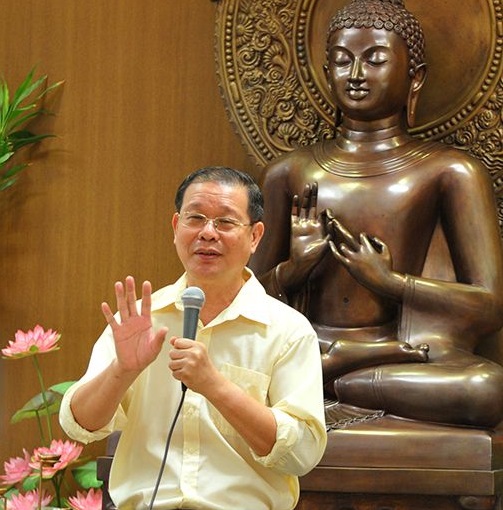ZEN MESTEREK ZEN MASTERS
« Zen főoldal
« vissza a Terebess Online nyitólapjára

陈明信 Piya Tan (1949-)
http://en.wikipedia.org/wiki/Piya_Tan
Piya Tan Beng Sin (Chinese: 陈明信 ; born 20 August 1949 in Malacca, Malaysia), also known as Piya Tan or Piyasilo (monastic name), is a Peranakan full-time lay Buddhist writer-cum-teacher in Singapore.
http://dharmafarer.googlepages.com
http://dharmafarer.org
PDF: Transmission outside the scriptures?
Contents
106 (5) Transmission outside the scriptures? Religion, power and change; some things we can learn from history.
106 5.1 Bodhi,dharma and the Chan lineage.
106 5.1.1 Who was Bodhi,dharma? Figs: (a) Bodhidharma (woodcut print); (b) Daruma doll.
107 5.1.2 The Chan root quatrain.
107 5.1.2.1 The Bodhidharma verse.
109 5.1.2.2 Wúyuè 吳越 and Fǎyǎn Chán 法眼禪.
109 5.1.2.3 Wúyuè 吳越: Zanning 贊寧 and Yanshou 延壽.
110 Opposing views.
110 5.1.2.4 Cáodòng 曹洞 ascent.
112 5.1.2.5 Jǐngdé zhuàndēng lù 景德傳燈錄 and Fózǔ tǒngjì 佛祖統紀.
112 5.1.2.6 Tiānshèng guǎngdēng lù 天聖廣燈錄.
113 5.1.2.7 The Buddha’s flower and Mahā Kāśyapa’s smile.
115 5.1.2.8 Chán violence.
116 5.1.2.9 Chán lineage.
118 5.1.3 The koan.
118 5.1.3.0 Gōng’àn 公案 and kānhuà chán 看話禪.
120 5.1.3.1 Chán and doubt. Gāofēng Yuánmiào 高峰原妙.
121 5.1.3.2 Dàhuì Zōnggǎo 大慧宗杲; Fig: Dahui Zonggao.
124 Dahui’s women disciples.
124 5.1.3.3 Dàhuì Zōnggǎo 大慧宗杲 and kānhuà chán 看話禪.
126 5.1.3.4 “Transmission of the Lamp.”
127 5.1.3.5 How to huàtóu 話頭.
128 5.1.3.6 Dead-word (sǐzì 死字) and live-word (huózì 活字).
129 5.1.3.7 Who is fit to talk with?
130 5.1.3.8 Do not give Zen answers!
132 5.2 Northern-Southern schools controversy.
132 5.2.1 Shénxiù and Huìnéng.
132 5.2.1.1 Disciples of Hóngrěn 弘忍.
133 5.2.1.2 Who was Shénxiù 神秀? Fig: Yuquan Shénxiù
134 5.2.2 Wǔ Zétiān 武則天.
134 5.2.2.1 Rise to greatness. Fig: Empress Wǔ Zétiān
135 5.2.2.2 Wǔ Zétiān as Maitreya.
136 5.2.2.3 Wǔ as patriarch-maker.
137 5.2.2.4 Wǔ Zétiān and Shénxiù 神秀.
137 5.2.2.5 Dreams of a Buddha-land.
138 5.2.2.6 Shattered dreams.
138 5.2.3 Shénhuì 神會, creator of modern Zen?
138 5.2.3.1 “Metropolitan Chán.”
140 5.2.3.2 Shénhuì attacks the “Northern” school.
141 5.2.3.3 Shénhuì fabricates Chán history.
142 5.2.3.4 Shénhuì exile.
142 5.2.3.5 Ordination certificates.
143 5.2.3.6 The power of money.
143 5.2.3.7 The seventh patriarch.
144 5.2.3.8 Worldly success and religious truth.
145 5.2.3.9 Buddhism “without boundaries”?
146 5.2.3.10 Seekers beware!
146 5.2.4 The real Sixth Patriarch (liùzǔ 六祖).
146 5.2.4.1 Humble beginnings. Fig: Huìnéng 慧能 depicted as tearing up sutras.
147 5.2.4.2 Huìnéng’s 慧能 charisma.
149 5.2.4.3 A native of south China.
149 5.2.4.4 Verses of Shénxiù 神秀 and Huìnéng 慧能.
151 5.2.4.5 Huìnéng becomes a monk.
151 5.2.4.6 Huìnéng’s teachings. Fig: Mummified remains of Huìnéng.
152 5.2.4.7 The roots of “no-thought” (wúniàn 無念).
153 5.2.4.8 Shénhuì the mastermind.
153 5.2.4.9 Conclusions.
154 5.2.5 The real Platform Sutra (Liùzǔ tán jīng 六祖壇經).
154 5.2.5.1 The Mògāo-caves texts.
155 5.2.5.1a Fig: Mògāo Caves (Mògāo kū 莫高窟), Dūnhuáng 敦煌.
155 5.2.5.1b Fig: A cave shrine, Mògāo Caves, Dūnhuáng.
154 5.2.5.1c Fig: Paul Pelliot in Cave 16, Dūnhuáng, 1908.
155 5.2.5.2 The Platform Sutra is not a sutra.
157 5.3 Politics of enlightenment.
157 5.3.1 Chán politics.
157 5.3.2 Legitimization through lineage.
160 5.3.3 The spirit of the Dharma.
160 5.4 Lidai fabao ji.
160 5.4.1 Dūnhuáng-cave text.
161 5.4.2 A text of thoughtless purity.
162 5.4.3 Shénhuì’s robe.
163 5.4.4 Versions of the Platform Sutra.
164 5.4.5 Wǔ Zétiān’s robe.
166 5.5 Chán: A reappraisal.
166 5.5.1 Chán too follows the gradual path.
168 5.5.2 Chán monastics are just like other monastics.
168 5.5.2.1 Does Chán really point directly to man’s mind?
168 5.5.2.2 Is Chán really about “sudden enlightenment”?
169 5.5.2.3 Chán is not all work.
170 5.5.2.4 Chán is not for everyone.
171 5.5.3 Chán Buddhism and the dead.
172 5.5.4 Why Chán masters are not awakened.